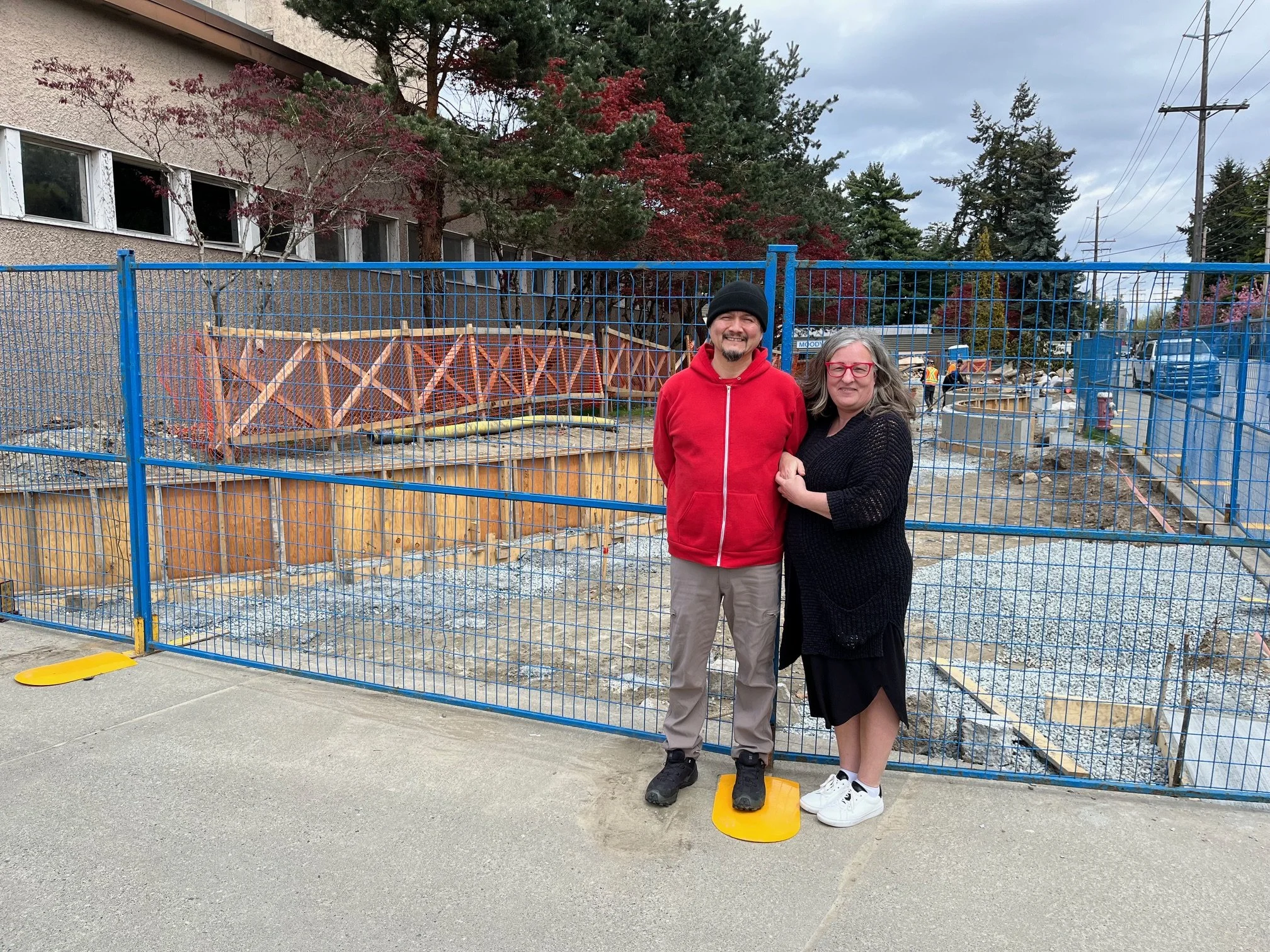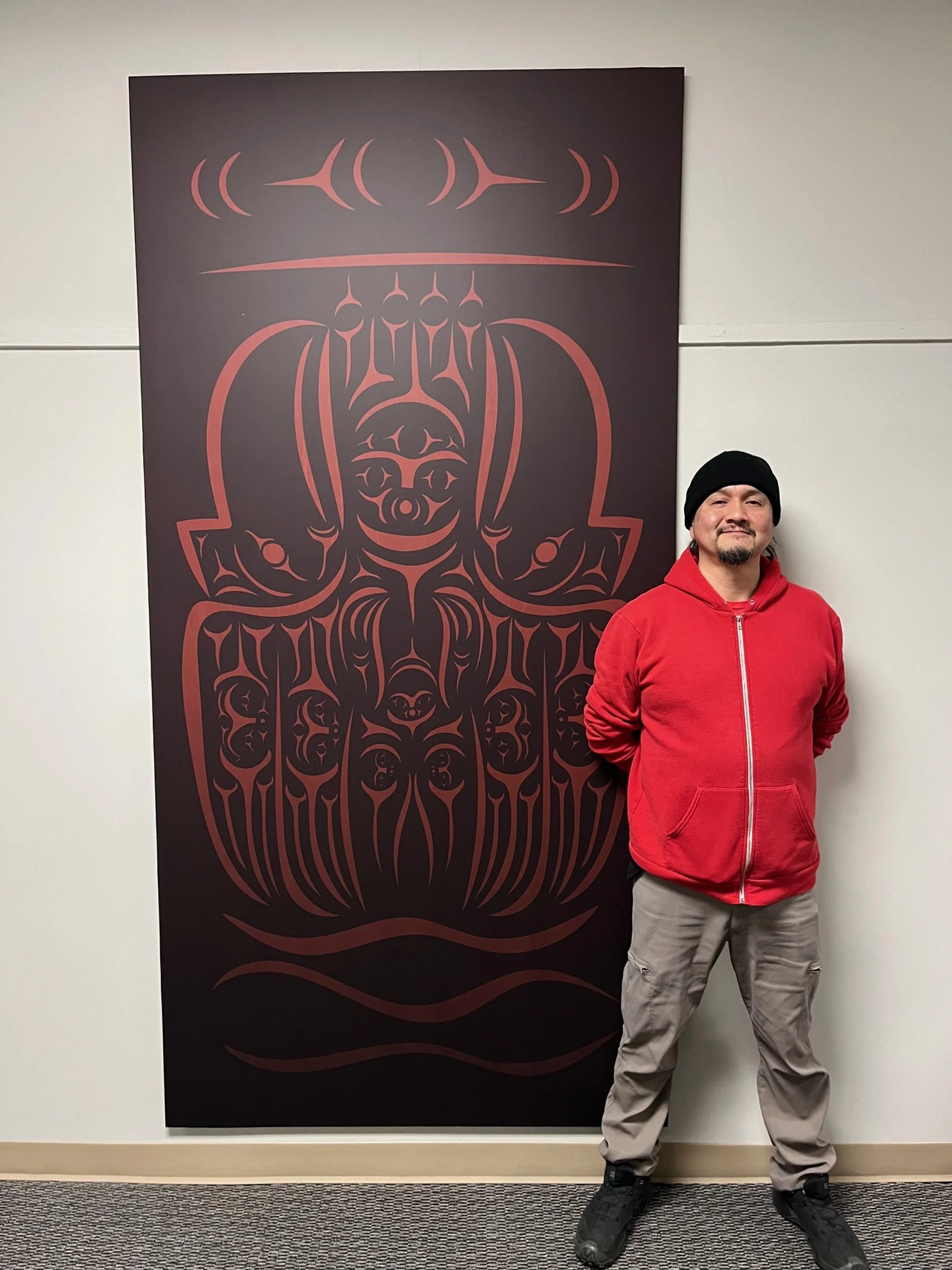Eighth & Eight Creative Spaces plants seeds for new Indigenous-led art-filled garden and gathering space
At the New Westminster complex that houses Massey Theatre, an outdoor area is being revived for Indigenous culture and ceremonies
Ronnie Dean Harris (left) and Jessica Schneider. Photo by Gail Johnson
A NEW INDIGENOUS-LED garden and gathering space with public art is taking root at Eighth & Eight Creative Spaces in New Westminster.
Eighth & Eight Creative Spaces comprises more than 75,000 square feet of the Massey Theatre Arts Complex, which includes the Massey Theatre, Plaskett Gallery, two multipurpose studios, two performance studios, a dance studio, digital labs, and the forthcoming garden/gathering space. What was once an unused patch of grass adjacent to the complex is being transformed into an outdoor destination where Indigenous culture and ceremonies can take place and where people can sit and take it all in. The new spot will be home to approximately 50 native Indigenous plants, including thimbleberries, salmonberries, salal, grasses, flowers, and more, in an effort for the land to recognize itself.
“We want to welcome people into their relationship to the place,” Ronnie Dean Harris, Massey Theatre’s Indigenous cultural developer and lead artist/researcher behind the project, tells Stir in an interview on-site. “We wanted to create something that had a central gathering space where you could sit and reflect, kind of centralize, locate yourself in the land. Cherry blossoms are beautiful, but they’re not from here.
“With my grandparents, we had a very rich culture of doing cultural burnings for our ancestors,” adds Harris, who also goes by Ostwelve, and who is of Stō:lo/St’át’imc/Nlaka’pamux descent. “It was a big deal; it’s very meaningful. There’s strict protocol. So I thought, what if we had a space where we could do that safely, where we could make those offerings?’”
Harris has been working closely with Jessica Schneider, Massey Theatre’s executive director, on the project for several years, consulting with other designers, artists, community advisors, and knowledge keepers.
“We knew that this building is set for renewal, which means it will be entering into a new interpretation of what it is, now that it’s not a high school anymore,” Schneider says. “And so, it was very important for us in our work to say ‘We have this opportunity to completely broadcast a different future.’ It’s sitting on this piece of land that was a cemetery burial ground before it was a high school. This big edifice is going to be sitting there with a different relationship to the site and to the community. And so, how can we put forward the cultural work in a really clear way so that it can inform the renewal, and also welcome people in the new way that we want to welcome people in to the relationship to the place?”
Ronnie Dean Harris with one of his artworks (unnamed, made of vinyl and aluminum) that is on display inside Eighth & Eight Creative Spaces. Photo by Gail Johnson
Several Indigenous artists have contributed artworks that will be displayed in an on-site structure that echoes the ancient framework of Coast Salish plank houses. In addition to public art, the structure will be home to Halkomelem language installations. Participating artists include Kwantlen First Nation member Atheana Picha, Rain Pierre (sɬə́məxʷ, Katzie), Diamond Point (Musqueam), and Hailee Stogan (Musqueam). Kaitlyn Cunningham (Kwikwetlem/Katzie) is the project’s language consultant.
“It’s a place to gather,” Harris says. “It’s a place to reflect.
“We were really looking at this idea of how our ancestors held story in place,” he adds. “There’s two concepts we really leaned into. With sqwelqwel, it’s these human stories that exist, like where you hunted, where you fished, how you're connected to other people. And then sx̱wóx̱wiyám is…you could call it mythological times, but it comes from a time of transformation.”
A large video exhibition screen will also show Indigenous media-arts projects in the garden space.
The team is working to connect the outdoor space to indoor programming as well. Inside, there will be an immersive, interactive exhibition focused on the stories of the land.
The outdoor space, which could be used for Indigenous markets and craft sales down the road, will be ready for use starting this summer.
“As our goals to create a framework for urban Indigenous connections became grounded, we were able to secure grants from Heritage BC, Canadian Heritage, and Vancouver Foundation to bring this project to life,” Schneider says. “I can’t think of another space like this, not just in New West, but in all of Metro Vancouver.” ![]()














